“Olive Grove” by the sea Population: 1,400
Old name: Trilye, Triglia
Market day: Thursday
On the southern shore of the Sea of Marmara, just a few short hours by boat and bus from İstanbul, Trilye is one of those unfortunate towns that seems to have suffered an identity crisis when its name was changed to Zeytinbağı (Olive Grove) in 1963. Zeytinbağı isn’t a name which seems to resonate with the locals unlike the older one about which many stories were told, including the possibly fanciful one about three priests who disagreed with their archbishop during the course of one of the Councils of Nicaea (İznik) and were exiled to Trilye, which therefore supposedly means ‘three priests’.
The majority of the local Greeks who had to leave in the 1923 population exchange were resettled in Rafina in Greece. The Turks who took their place came mainly from Salonica and Crete.
Around town
It doesn’t take long to realise what a magical place this is. The high street is lined with cute little shops, some of them selling upmarket versions of the olive oil which would once have been the town’s primary source of wealth. Huge, shady plane trees dot the street and, beneath them, old men sit selling juicy purple figs lined up in boxes like toy cars.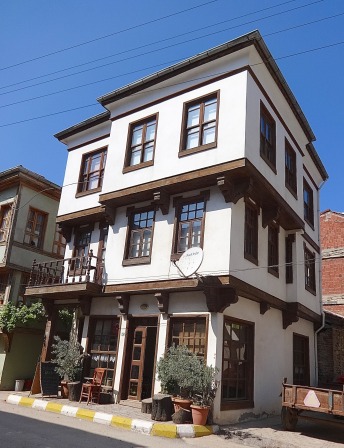
There are one or two pleasant-looking cafes that exude the air of sleepy Greek tavernas – although, of course, none is selling anything harder than tea. The most inviting is the Orta Kahve which, with its stained-glass windows, is vaguely reminiscent of the Taş Kahve on Cunda island.
A solid stone building right in the middle of the street was once the Agios Vasileos (St Basil) church and then the refectory for a local orphanage. It has been restored to serve as a cultural centre.
The main street runs straight out into the countryside, passing abandoned reminders of the old olive-oil industry. Huge brick sheds stand forlorn, their tall chimneys no longer belching out smoke. If you peek through the windows you’ll see that some of them were abandoned so speedily that their machinery still stands in place as if the workers were expected back any day soon.
Other abandoned workplaces would have been used for making wine and for rearing valuable silkworms for sale in nearby Bursa.
In the opposite direction the main street runs down to the sea where a regular platoon of flashy fish restaurants – the Şekerev, the Liman, the Savarona and the İskele – and rather more down-to-earth lokantas are lined up to take dinner orders.
A promenade sweeps round to the east, passing a small farmer’s market and a few hopeful retailers of seaside trinkets, on its way to a fishing harbour. In the other direction it comes to an abrupt halt in front of a litter-covered shingle beach.
If you cut in sideways from the main street you will stumble upon an abandoned Ottoman town with multi-storied wooden houses lined up, one beside another, their ground floors fitted out as shops with neat panes of glass in their windows and big shutters made out of planks to secure them.
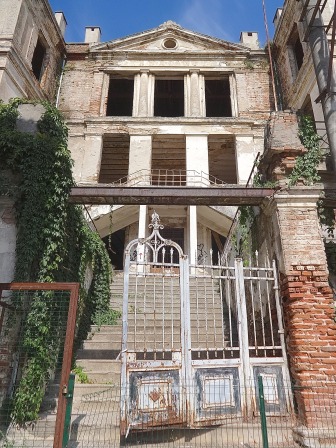 Soaring above them at the top of a steep flight of steps is a building that suggests that this was a town that placed a high value on learning. The Taş Mektep (Stone Primary School), built between 1909 and 1912, is extraordinarily large to have served as the local school and the explanation for its extreme size lies in the fact that it started life as school for priests. It was restored in 1921 to became a Kent Müzesi (City Museum).
Soaring above them at the top of a steep flight of steps is a building that suggests that this was a town that placed a high value on learning. The Taş Mektep (Stone Primary School), built between 1909 and 1912, is extraordinarily large to have served as the local school and the explanation for its extreme size lies in the fact that it started life as school for priests. It was restored in 1921 to became a Kent Müzesi (City Museum).
The second building that hints at the town’s former glory is what was once the church of Hagios Stephanos (AKA the Büyük Kilise) and is now the Fatih Cami. This was an equally outsize church, domed, apsed and with a narthex whose marble columns boast capitals of exquisite Byzantine basketwork. Its history seems uncertain although it may have started life as an 8th-century monastery. Unfortunately it has been ‘restored’ by builders who have outlined every last stone and then daubed the structure with an unlikely reddish wash.
Inside, however, the Byzantine columns, capitals and marble wall panels still survive, calling to mind the lovely Küçük Ayasofya Cami in İstanbul. 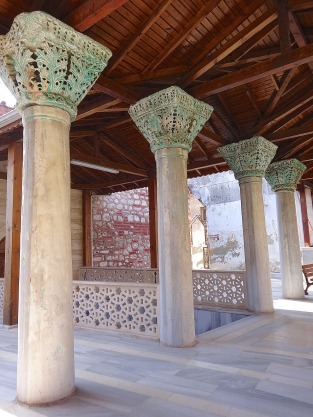
The remains of a16th-century hamam nearby have been restored to their early Ottoman appearance.
A second church, the 8th-century Kemerli Kilise (Panagia Pantovasilissa, Church with Arches), has so far managed to escape restoration which makes it easier to imagine its original beauty despite its dereliction. Neat Byzantine brickwork is interwoven with pieces of marble that must have been taken from Roman structures, suggesting that there was an older settlement here for which there are no records.
If you peep through the windows you can see fine marble columns and what look like fading medieval frescoes on the walls. But the courtyard is full of fig and plum trees; it’s a miracle that the central dome has not yet caved in. In 2013 the Patriarchate in İstanbul bought the church back again. It remains to be seen what they will do with it.
A third church is easier to overlook because it has been converted into a house, hence its name, the Dündar Evi Kilise (Hagios Giorgios Ano). Once upon a time this, too, must have been an imposing building, a reminder that what is now a Turkish Muslim town was, not so very long ago, predominantly Greek and Christian.
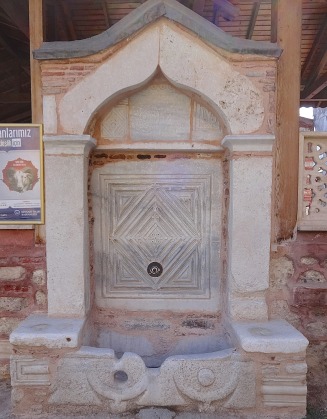 Even if your schedule doesn’t allow time for a meal in the harbour it’s still worth strolling up onto the headland where the Tarihi Çamlı Kahve offers tea and snacks with a wonderful view out to sea. It’s a very windy spot so chances are that you’ll have to retreat to the shade of a clump of ancient pines draped with an interesting assortment of pots and pans.
Even if your schedule doesn’t allow time for a meal in the harbour it’s still worth strolling up onto the headland where the Tarihi Çamlı Kahve offers tea and snacks with a wonderful view out to sea. It’s a very windy spot so chances are that you’ll have to retreat to the shade of a clump of ancient pines draped with an interesting assortment of pots and pans.
Much of the pleasure of a visit to Trilye lies in quietly soaking up the details: the Graeco-Roman tombstones and Byzantine panels reused in the creation of çeşmes (drinking fountains); the street names that tell the story of a lost world of trade – Demirhane Sokak (Ironworks St), Sebzeci Sokak (Vegetable-Seller’s Street), Marangozhane Sokak (Carpentry Shop St), Yağcı Sokak (Oil-Seller’s Street) and Zeytinlik Aralığı (Olive Grove Passage).
Stay the night here and you’re unlikely to regret it.
Eating
Meyhane culture is alive and kicking in Trilye with a line of fish and meze restaurants lined up along the waterfront, a coterie of musicians doing the rounds to ever greater applause as more and more rakı is downed. I ate at Trilye Balık (Tel: 0224-563 2553) and loved my meal. I’m sure its neighbours were just as good.
Sleeping
Çınar Motel. Tel: 0224-563 2033
Trilye Hotel. Tel: 0224-563 2220
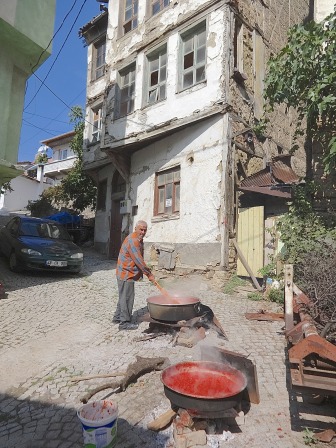 Making salça (tomato paste) in Trilye back streets in autumnTransport info
Making salça (tomato paste) in Trilye back streets in autumnTransport info
Take a BUDO ferry (https://budo.burulas.com.tr/Default.aspx) from Eminönü in İstanbul to Mudanya. Buses from just in front of the harbour run to Trilye, 10km further west along the coast.
Day trip destinations
Read more: http://turkeyfromtheinside.com/blogbloggingaboutturkey/entry/87-the-man-from-trilye.html


